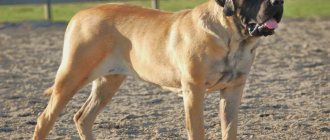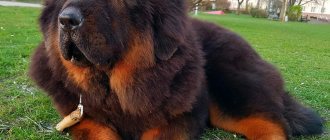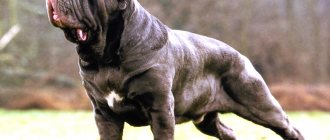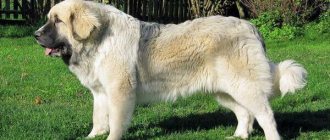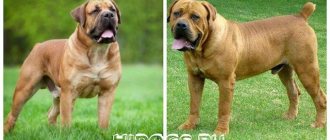Appearance of the Tibetan Mastiff
General impression
What does Tsang Khi look like? What can be seen from the photo: Tibetan mastiffs are large, massive, but proportionally built. The muscles are dense, a large accumulation of fat under the skin, even despite being well adapted to the cold, is small and evenly distributed. Animals may differ in appearance or physical structure depending on their habitat and the nutrition they receive as puppies.
Head
The head looks broad and heavy. The skull is rounded, the occipital protuberance and stop are well defined. Triangular ears are located just below the skull, falling forward; When a Tibetan experiences strong emotions, the ears move actively.
The square-shaped muzzle is wide and well filled. Eyes with tight-fitting eyelids are oval or semi-oval in shape, slightly squinting. Brown color and its various variations are desirable (either the color of the iris close to the color of the coat, or dark brown). The nostrils of the black nose are well open. With its fleshy lips, the dog covers the lower jaw with a regular scissor bite (a direct bite is allowed).
Neck
A strong and muscular neck is prescribed for Tibetans, as is a well-defined scruff. Males have thicker fur than females.
Torso
The body is powerful, with a straight back and wide croup. The lower part of the deep, moderately broad chest falls below the elbow joints; ribs are rounded. The muscles of the body are well developed.
Forelegs
Strong bones of straight paws, an average slope of the shoulders, elbow joints facing backwards, and straight forearms are prescribed for Tibetan Mastiffs according to the standard. The pasterns are slightly inclined. The muscles of the paws are developed. The paws are round, the toes are curved. The fur collects in clumps between the fingers. The color of the dense pads is black.
Hind limbs
The parallelism of the hind legs is noted. The croup is voluminous, the hips are strong. The stifle joint is well defined, the hock joint is low and strong. Developed muscles allow you to make good pushes. The paws are rounded, the toes are curved. The color of the pads is black.
Tail
The high-set tail is long enough to fall down the back. If the animal is excited or hostile, the tail is thrown freely over the croup or kept a couple of centimeters from it.
Movements
The movements of the Tibetan mastiff show sedateness and importance. When walking, the fluffy giant pushes easily and evenly with both hind and front paws. During running, the emphasis shifts to the hind limbs due to more developed muscles.
Wool
The Tibetan Mastiff's coat is distinguished by the coarseness of its short guard hairs. In winter, the undercoat is thick; by summer, during spring molting, the amount of hair is reduced by one-half. Abundant fur is observed on the neck, shoulders, and tail.
Color
What colors are typical for the hairy giant? There are five types of Tibetan mastiff colors: black, black and tan, blue (gray), golden (all possible shades from wheaten to reddish), sable. Purity of shade is welcome, but there may be some scorching on the shins and lower part of the tail. The eyes may be surrounded by glasses. The color of the tan marks depends on the color of the furry giant.
Size
Tsang-khi are large breed dogs that grow up to four years. Weight increases in proportion to height; animals are genetically protected from obesity. Compared to an adult giant, a one-month-old puppy is very small, but every month it gains weight (norms for weight gain can be found from the breeder or can be found on the Internet). “Boys” and “girls” have quite large differences in physical parameters. With a minimum height of 66 cm, a male weighs from 72 to 80 kg; The height of Tibetan mastiff females is slightly smaller, 61 cm, and their weight is from 60 to 75 kg.
Character of the Tibetan Mastiff
Do not be afraid of its menacing appearance: the Tibetan mastiff is affectionate and quite good-natured. Balance and independence are in the dog’s blood, just like other breeds in this region. The Tibetan does not need constant attention from the owner due to its highly developed independence, which makes it different from dogs of small breeds: the animal can easily communicate the need for a walk, choose a time for playing outside, sleeping, and eating. Aggression and inadequacy are rare among Tibetan mastiffs, as they are considered the reason for not allowing an individual to breed. But despite this, dogs become excellent guards. Their loud bark is surprisingly booming.
Keeping such a giant (even a puppy) in an apartment is impossible due to its size, but it is important for a Tibetan to feel involved in the life of the “pack,” so the dog’s life should take place at home. At home the dog will behave approximately. Tsang-khis are affectionate with children (it is not recommended to leave children alone with animals due to their size), and they easily get along with other animals - even cats and dogs of the same sex. This allows us to conclude that the character of the Tibetan mastiff is as calm, friendly and balanced as possible.
Walking with Tibetans is a real pleasure. They look great outside in winter.
Tsang-khis are surprisingly smart and obedient. Thanks to this, furry giants can be trained with due care and patience of the owner. The owner becomes the “pack leader” for the Tibetan Mastiff, and carrying out his commands is a priority. When in the company of a stranger, a Tibetan will attack only on the orders of the owner.
Who is Tsang Khi suitable for? An authoritative person who has already kept a dog. If you have a dog of this breed, get ready to switch to an active lifestyle. Only the Tibetan owners know how cheerful animals can be when they explore this world.
Breed Features
The Tibetan Mastiff does not single out one owner.
The pet will treat all family members equally, but shows special affection towards children. Kids can do whatever they want with a dog. And during such games, you need to ensure that the child does not harm the patient dog. It is difficult for a large dog to move, so you should not expect much activity from it during games. But while the mastiff is still a puppy, he enjoys playing with all family members. If no one wants to bother with him, then the puppy will calmly lie down in his place and will not bother the owners.
A reliable and independent dog is a guard and a protector at the same time. He may not wait for the command and resolve issues related to his work on his own. No one can hide from a serious adult gaze. A pet is capable of giving its life for an owner who has earned his love and trust.
Tibetan Mastiffs are self-sufficient and can easily be alone. They only need attention to feel affection. Dogs have good intelligence and developed intelligence. At the same time, they are stubborn and able to defend their point of view. However, they do this in such a way as not to offend the owner.
Mastiffs do not pay any attention to small dogs, even if they bark at a large dog. But they can respond to the aggression of large individuals.
In a family, the pet will participate in common affairs and feel the mood of the household. If there is discord in the family, then the dog will become sad.
READ Russian Toy Terrier breed description character care and maintenance feeding history
The main character traits of the Tibetan Mastiff include:
- distrust of strangers;
- does not show aggression in front of family members;
- knows how to control his ardor, because he has a restrained character;
- protects everything that is dear and familiar to him;
- balanced, calm and does not rage for no reason.
A large pet easily takes root in both small and large families, where it will become everyone’s favorite.
A lion's thick mane, a massive body, a large head and an absolutely pretty look: in front of you is a dog from which it is impossible to take your eyes off - the Tibetan Mastiff. The oldest type of breed that served as a guard in Tibetan monasteries. A calm, kind dog who can be part of a friendly family, treat his owners and children kindly, and guard the house with dignity.
Thanks to its dense coat, the mastiff can live freely on the street and easily tolerate low temperatures even without a kennel. Unlike other dogs, a mastiff is unlikely to run fervently to catch a thrown ball or stick: he is independent of his owner, although he is loyal to him. This breed was bred to protect humans and their homes, so the dog prefers to stay awake at night and sleep peacefully during the day.
The mastiff is smart, majestic, reacts adequately to other people’s aggression, but requires respect for one’s own person and an understanding of canine psychology. If you have never owned a dog, then you should prepare to raise this breed: a mastiff will grow up to be a wonderful dog with systematic training and proper attention to the process of its socialization. Otherwise, the dog becomes unpredictable and suspicious of strangers.
Education and training
Raising and training a Tibetan mastiff can be either easy or difficult - it all depends on the relationship between the owner and the pet. Dogs of this breed are smart but stubborn. An animal may not obey the owner if it does not recognize his authority (this is why it is not recommended for inexperienced dog breeders to own a dog of this breed). Such behavior of a Tibetan can be eradicated: one should be more patient, tactful and perspicacious.
It is recommended to start teaching a puppy simple commands at the age of one month, and full training only three or four months after birth. On average, Tsang Khi acquires the necessary skills in two years.
Training is best done under the supervision of a dog handler, outdoors (it doesn’t matter whether it’s winter or summer, spring or autumn outside). At first, each training session will be devoted to performing only one exercise, then, after the Tibetan has mastered several commands, two or three. A trained and well-mannered furry giant will always follow the instructions of the owner, even if instinct prescribes a completely different behavior in the situation.
In the matter of obedience to the owner, the aspect of trust is also important. If during training the animal does not ask for affection for a well-performed trick, does not try to lick the owner, but only eats treats, looking sideways at the person, it is worth thinking about where the mistake was made in the upbringing. Such an attitude towards the owner leads to problems with socialization.
How to raise a Tibetan? Questions are often asked: how to train a Tibetan mastiff not to bark at strangers, how to wean a puppy from gnawing wooden objects, and whether it is possible to swear at him. If it is not possible to contact a breeder or dog handler, then you should be patient and show the animal (in a gentle way) that such behavior is unacceptable (you cannot use screaming). We also must not forget about the importance of early socialization: mastiffs are very self-centered.
How to train and what commands to teach?
The Tibetan Mastiff is a calm and slow dog, which means training should take place in the same spirit. There is no place for haste and fuss. At the same time, this dog is a leader and special skills will be required here.
Commands to learn:
- "Place". Usually, after a meal or a walk, the puppy wants to rest, but he can sit anywhere. And this is the time to learn. Take the baby to his place and firmly say the command. Do this every time your pet lies down (example in the photo).
- "To me". Accustoming to this command occurs during a walk. A leash is used as an assistant. Without releasing the dog from the leash, say the command loudly and lightly pull the leash; when the baby approaches, praise him. Repeat the procedure every time you walk.
- "Walk". This command is taught to the puppy when getting ready for a walk. While putting the leash and collar on him, calmly say the command several times.
- "Sit". In order to accustom your dog to the command, hold a treat in your hands and say loudly, “Sit,” while pressing the pet’s croup with your other hand. When the puppy sits, praise him and give him a treat.
- “Fu” - training to this command occurs strictly, and treats are not used. Whenever your dog does something that is not allowed, say the command firmly and distract your pet with something. The main thing is to let your pet know that you are not happy with his actions.
Tibetan Mastiff Health and Diseases
Possible diseases
The Tsang-Khi are surprisingly healthy (this is due to living for many years in the snow-capped mountains), but their life expectancy is short. The furry giants even have a gene responsible for preventing the development of obesity. But, despite this, large body weight is normal for the breed, as a result of which diseases of the musculoskeletal system develop.
Diseases of the endocrine system and eye diseases may occur. In addition, Tibetans are susceptible to ear infections, because their ears are in constant contact with fur, which is why they are not ventilated enough.
The most common diseases are:
- Hip dysplasia is an inherited pathology that results in impaired development of the head of the hip joint. It appears while walking - the pet cannot step on its paw normally;
- elbow dysplasia;
- eye diseases (entropion or eversion of the eyelids);
- baldness (most often the tail is affected);
- rickets;
- thyroid diseases;
- dermatitis (due to the abundance of hair, an animal living in damp rooms can acquire this disease);
- autoimmune hypothyroidism is a chronic disease characterized by the production of lymphocytes that produce antibodies to thyroid cells.
It is necessary to monitor the condition of the Tibetan Mastiff's muzzle: rubbing the eyes and nose should become a constant part of the pet's daily toilet, as well as combing. Oral diseases are not typical for Tibetans, but it is important to monitor the condition of your pet’s teeth - caries or tartar may occur. Allergies in dogs of this breed are rare.
Reproductive health
A special topic is the health of bitches. Their life is inextricably linked with the birth of offspring. The first heat occurs at approximately two and a half years of age. It is better to postpone pregnancy planning and childbirth to the second or third heat.
If the owner is not financially ready to breed Tibetans (it is important to think about who the breeding will take place with, what to feed the puppies after weaning from the female, how documents will be drawn up, and marks for receiving vaccinations), the best option would be sterilization. In this case, you will not have to spend money on expensive treatment and recovery after childbirth.
Features of feeding and diet
Proper nutrition should accompany the Tibetan Mastiff from birth. The formation of an individual ends at four years of age; until this moment it is better to use the puppy’s feeding guide, otherwise there is a high chance of not taking into account all the subtleties of building the animal’s diet. The consequence may be weakness of the muscle corset, brittle bones (a month-old puppy must receive the required amount of calcium). Every month the amount of food consumed by the mastiff will increase - feeding is considered the most expensive part of keeping Tibetan mastiffs.
Whether to base the diet on natural food or gradually switch the animal to dry food is up to the owner of the Tibetan mastiff to decide. Mixing two types of diet is strictly prohibited, as this can lead to indigestion and other problems with the gastrointestinal tract.
If the owner decides to leave the pet on a natural diet, then he should purchase a guide on feeding an adult dog. Such manuals prescribe the norm for obtaining KBJU and microelements, an approximate diet, and also state whether the animal can consume certain foods.
Products recommended for inclusion in the diet include:
- beef;
- offal (except chicken bones);
- lean meats and poultry (rabbit, chicken, turkey);
- sea fish and seafood;
- cereal porridge;
- unsweetened vegetables and fruits;
- fresh vegetables (except starchy vegetables);
- vegetable fats (oils).
When transferring a furry giant to food, you should pay attention to the animal’s body’s reaction to the components of the food. The transition occurs slowly: at first, food is added to the food in small handfuls, then most of the food is replaced by dry food and, in the end, the animal is completely transferred to food. It is possible for the food to soften in water, especially if the puppy is being fed.
Typically, an adult Tibetan receives two servings of food per day, a puppy – three to six servings. The amount of food depends on age. Water should be available all day and should be changed every two hours.
How to feed correctly and how often?
A very small puppy is fed 6 times a week in small portions.
From 3-4 months, the pet is transferred to 5 meals a day and the portions are slightly increased.
At 6 months the baby can be fed 3 times.
At 8 months the pet eats 2 times a day. In this case, the volume of portions should correspond to the norm for an adult dog.
Menu for the week
Monday:
- Breakfast - cottage cheese or yogurt.
- Lunch – buckwheat with a piece of beef.
- Dinner – boiled fish with cabbage.
Tuesday:
- Breakfast – cottage cheese or kefir.
- Lunch – chicken with carrots, egg.
- Dinner – boiled veal with cabbage or beets.
Wednesday:
- Breakfast - meat broth and egg.
- Lunch – oatmeal with a piece of turkey.
- Dinner – boiled carrots with veal.
Thursday:
- Breakfast – cottage cheese or yogurt.
- Lunch – rice porridge with turkey.
- Dinner – oatmeal with a piece of fish.
Friday:
- Breakfast – chicken broth, egg.
- Lunch - buckwheat with boiled veal.
- Dinner – a piece of chicken with boiled carrots.
Saturday:
- Breakfast – boiled fish with cabbage.
- Lunch – oatmeal with a piece of veal.
- Dinner – chicken broth, stewed beets.
Sunday:
- Breakfast - sour milk, yogurt or cottage cheese.
- Lunch – buckwheat porridge with scalded liver.
- Dinner – stewed cabbage with fish
TM puppies are large and big-boned. Therefore, they need a large amount of calcium-containing foods to prevent rickets.
Care and maintenance
The Tibetan Mastiff dog is very large, which makes keeping it in an apartment problematic. A country house would be a good option for a Tibetan, but the dog cannot be kept completely outside, as it needs constant communication with its owner. Also, you cannot put a Tibetan mastiff on a chain, this will harm the animal’s psyche. For a four-legged guard, you can build a spacious enclosure. Do not forget that such a dog must be walked outside the territory of its residence.
How to care for a Tibetan Mastiff dog? The Tibetan's coat, due to its origin and long residence in mountainous areas, is very thick. The dogs are long-haired. It will take some time to care for her. It is especially difficult to care for a mastiff in the spring, when the molting period begins: every evening you will have to devote to combing your pet and removing tangles.
The rest of the time, it is enough to comb the Tibetan 2-3 times a week.
Often the appearance of tangles, which are removed using a tangle cutter or a special spray. Bathing a mastiff occurs infrequently: once every three months. If you don't have enough time, you can use dry shampoo.
Claws are trimmed as they grow, mainly in winter, since during this period the pet is not able to grind them off on the asphalt on its own. This procedure is carried out using a nail clipper for large dogs, and the remaining irregularities are ground down using a hard file. The fur often gets tangled between the Tibetan's fingers, which is why it is cut once a month.
Mastiff ears need just as much care. As the auricle becomes dirty, wipe it with a cotton swab soaked in chamomile infusion. Eyes that become dirty due to hair getting into them are wiped with boiled water every two days.
The oral health of a pet is entirely in the hands of the owner. It is recommended to brush your pet's teeth twice a month. An unpleasant but important procedure for khi is carried out using a toothbrush or a finger attachment, as well as a special toothpaste. You can free the Tibetan Mastiff from unpleasant manipulations by introducing into the diet special treats developed by specialists to prevent the appearance of plaque.
Tibetan Mastiffs participating in exhibitions should visit the groomer once every one and a half to two months. Pet-class or breed-class dogs are recommended to visit a specialist at least once every six months. Grooming includes a range of services: haircut, teeth and ear cleaning, nail trimming, and fur combing. Otherwise, the care and maintenance of the Tibetan mastiff falls entirely on the shoulders of the owner.
Content
This is the largest of all pets; naturally, the Tibetan mastiff should live on the property of a private house. The apartment will not be spacious enough for him. A dry, cool climate suits it best. Observing your ward, you can notice that bad weather, wind, snowfalls give him pleasure. He happily swings through the snow, but on a hot summer day he tries to avoid the hot sun.
This is the largest of all pets, naturally, the Tibetan mastiff should live on the site of a private house
The breed of immigrants from Tibet needs to create appropriate conditions. It is better to prepare an enclosure and arrange a booth. The area of the fence should be at least 6 square meters, the height should be about 2 meters.
In this territory, 1/3 should be occupied by a booth with a sunbed. It is advisable to make the floor wooden. You also need to build a canopy over this part of the area to provide shade. The free part of the dog's property is planted with lawn grass or covered with a layer of sand.
The following is not acceptable:
- concrete floor of the enclosure;
- keeping a Tibetan in the open air if there is no booth for him;
- an enclosure without an awning.
A dog requires attention, no matter where it lives - in the yard or in the house. Tibetans who have an enclosure need a long walk once a day. Dogs kept at home require more frequent walks. Constant movement helps maintain normal muscle tone.
Tips for choosing a puppy
How to choose a Tibetan Mastiff puppy? The choice is quite difficult, given the small number of nurseries engaged in breeding. Tibetans must be kept in good conditions: sleep and play in spacious rooms, and receive premium food after weaning. Tibetan Mastiff puppies with good pedigree can be purchased from the following kennels:
- Liontari Asteri (Saratov);
- Zatveretsky Posad (Tver);
- Sei Taishougum (St. Petersburg);
- AlpiNEN Gold (Belgorod);
- Light Stacy (Bryansk);
- Like Vizhe Trel (Moscow);
- Pharaoh's Dream (Moscow region).
It is advised to consult a breeder or dog handler, the cost of which is usually not high. A healthy puppy is curious and playful. A neat, healthy appearance, absence of suppuration on the skin or mucous membranes, fluffy but not crumpled hair is a good sign. Before buying, it is better to talk with the parents of your future four-legged friend to find out whether the puppy will be aggressive, cowardly or overly angry.
The price of a little Tibetan depends on the quality of his care after birth and the availability of documents (puppy birth certificate, which can be exchanged for a pedigree upon reaching a year, a veterinary passport with notes on vaccinations performed).
Dimensions and weight
On average, healthy TM puppies at the time of birth have a length of 20-27 cm and weigh 400-600g.
| Puppy age in weeks | Ongoing processes |
| 1 | The puppy's primary adaptation to the conditions of the surrounding world occurs: temperature and smells. During this period, the baby’s body is dense, elastic, covered with smooth hair. |
| 2 | The beginning of the transition period. The babies continue to grow actively, and by the end of the second week their weight increases 3 times. Towards the end of the second week, the puppies' eyes and ear canals open, and the baby begins to see and hear. The first baby teeth also appear. |
| 3 | At this stage, the puppies are little by little trying to get to their feet and take their first steps. By this age, thermoregulation improves, and the puppies begin to be less jealous of their mother. At the same age, they are allowed to try solid food. |
| 4 | The babies become more inquisitive and active, crawl out of the nest and begin to play with each other. At this stage, the personality of the future dog begins to form. |
